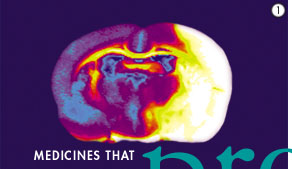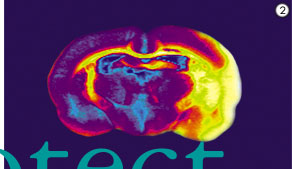Over 500,000 people in America will experience a stroke this year. How they are treated in the time immediately following the initiation of their stroke could make the difference between life and death, or their ability to resume a normal life or not.
|
|
 |
Whether the result of a car accident, stroke or chronic neurodegenerative disease, neurological trauma is something we hear about every day. But, what we have yet to hear about are the incredible treatments being developed that have the potential to protect cells from injury and death.
Guilford is attempting to provide hope for those who find themselves the victims of acute and chronic degenerative conditions by developing novel neuroprotectant compounds called NAALADase, PARP and NOS inhibitors. Each of our neuroprotectant programs seeks to slow down or prevent cellular damage and death, thereby providing protection to neurons and other cells that are at risk as a result of disease or injury.
This damage typically occurs from reduced blood flow (called ischemia) to the brain or other organs or tissues as a result of trauma or chronic disease. Guilford’s neuroprotectant programs form part of a three-tiered strategy that focuses on developing novel, small molecule inhibitors that can intervene at three distinct points in this complex and destructive biochemical cascade.
Research conducted by Guilford has suggested that our NAALADase, PARP and NOS inhibitors may be useful in preventing cell death in a variety of chronic and acute conditions, including stroke, septic shock and traumatic brain or spinal cord injuries, as well as chronic degenerative disorders including Lou Gehrig’s disease (ALS), Parkinson’s and Alzheimer’s disease, peripheral neuropathies and chronic pain.
NAALADase Inhibitor Program
The most advanced of our neuroprotectant programs is our NAALADase (N-Acetylated-Alpha-Linked-Acidic-Dipeptidase) Inhibitor Program. By inhibiting an enzyme called NAALADase, this program targets the earliest step in the complex biochemical cascade which leads to cell degeneration and death.
In the human brain, glutamate acts as a chemical messenger which helps to translate thoughts into actions. Glutamate also controls functions such as learning, memory and motor skills. Under conditions of acute or chronic neurodegeneration, excessive amounts of glutamate are released in the brain, causing cell toxicity and cell death. As a result, glutamate has been implicated in a large number of neurological disorders including stroke, Lou Gehrig’s disease (ALS), spinal cord trauma, Parkinson’s disease, diabetic neuropathy, and pain.
NAALADase is an enzyme that mediates the release of glutamate during conditions of neurodegeneration. Other pharmaceutical companies have focused on developing compounds that block glutamate from binding to glutamate receptors after it has been produced and released (called post-synaptic inhibition). Our program is unique, however, in that our NAALADase inhibitors protect cells by preventing harmful excessive glutamate release in the first place (called pre-synaptic inhibition).
This completely novel approach may offer many significant treatment advantages. Most importantly, it does not appear to interfere with normal glutamate functioning—a feature which is very important considering that glutamate is one of the most common chemical messengers in the brain. Moreover, we believe that this unique method of selective intervention may also entail fewer side effects than with previous approaches.
Guilford scientists have made significant progress identifying and testing multiple chemical structural series of novel NAALADase inhibitors with potency in inhibiting NAALADase activity and protecting against neurodegeneration. In late 1998 the Company selected the first lead NAALADase compound to pursue in human testing.
PARP Inhibitor Program
Guilford’s second most advanced program, our PARP (Poly-ADP-Ribosyl Polymerase) Inhibitor Program, targets what we believe is one of the last steps in the destructive cascade of events which leads to cell toxicity and cell death. As pioneers in this field of research, we have developed several classes of novel PARP inhibitors which have evidenced dramatic protective effects in several animal models of degenerative disease.
PARP is an enzyme which scientists believe may be activated to repair damaged cellular DNA. The activation of PARP, however, can deplete a cell’s energy reserves and ultimately lead to cell death. In an attempt to prevent this destructive cascade, Guilford’s PARP inhibitors work by blocking the PARP enzyme, thus minimizing subsequent cellular damage.
PARP inhibitors have the potential to treat many diseases where over-stimulation of PARP is implicated, including stroke, head and spinal cord injuries, diabetes, septic shock, myocardial infarction (heart attack) and Alzheimer’s, Huntington’s and Parkinson’s disease. Guilford is now focusing on selecting a lead PARP inhibitor to move towards clinical development.
The pursuit of a comprehensive intellectual property portfolio is a core part of our effort to build a strong neuroprotectant franchise. As of December 31, 1998, Guilford owned or had exclusive rights to over 40 U.S. patents and patent applications relating to compositions and uses of its NAALADase and PARP neuroprotectant technologies,as well as numerous corresponding foreign filings. Our patent estate puts Guilford in an excellent position to maximize licensing and commercial opportunities.
|







